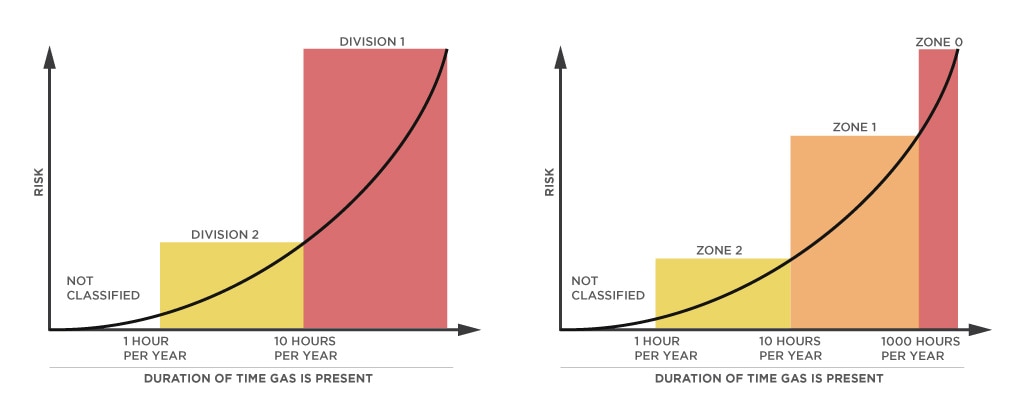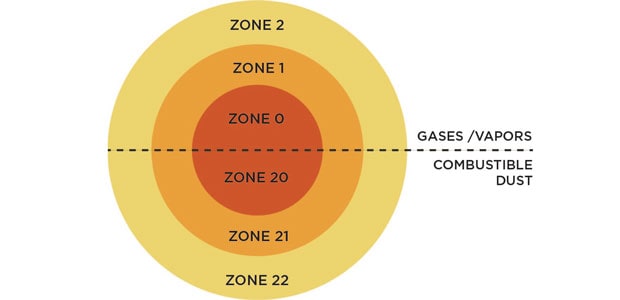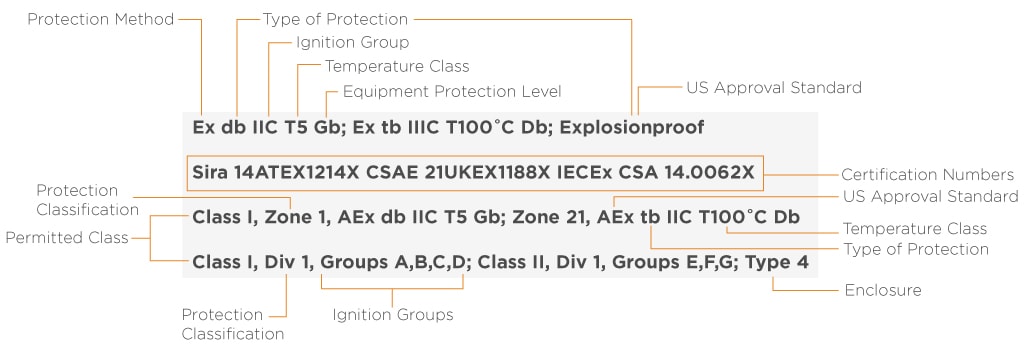
Industries
Hazardous Location Classifications
Requirements guide for material classifications in hazardous locations (HazLoc).
Hazardous locations (HazLoc) refer to areas where there is potential for an explosion or fire due to the presence of substances such as flammable gases, vapors, or combustible dusts. Common hazardous location industries include oil and gas, chemical processing, flour processing, textile mills, and mining. HazLoc material classification and certification plays a crucial role in ensuring the safe operation of equipment and preventing catastrophic incidents. Classifications for HazLoc are determined by various organizations and governing bodies.
About NEC and IEC
US & Global Standards
There are multiple organizations and governing bodies that provide classifications for hazardous locations. An overview and comparison of the National Electric Code (NEC) published by the National Fire Protection Association (NFPA) in the United States - defines classes, divisions, and groups, while the International Electrotechnical Commission (IEC) defines zones and groups for equipment in hazardous locations.
Classes | Zones | Divisions
The NEC developed HazLoc into classes, divisions, and groups, while the IEC developed a zone system with zones and groups. To limit confusion, the NEC divisions are based on hazards present during normal versus abnormal operations. For example, daily operations are compared to maintenance or troubleshooting tasks, whereas the IEC zones are based on how often, or the duration, the hazards present.

NEC Classes
There are many types and combinations of precautions to keep people safe in hazardous environments. The following are a few examples of general precautions associated with different NEC classes, divisions, and groups. Precautions include:
Class I: areas with flammable gases or vapors.
- Grounding and bonding: electrical equipment and conductive materials should be properly grounded and bonded to prevent static electricity buildup and sparks.
- Explosion proof enclosures: enclosures designed to withstand and contain internal explosions.
- Intrinsically safe equipment: Low-energy devices used to minimize sparking or heat generation.
Class II: areas where combustible dust is present.
- Regular cleaning and housekeeping: frequent cleaning to minimize the accumulation of combustible dust.
- Dust collection systems: systems to capture and remove dust particles from the air, preventing buildup on equipment and surfaces.
- Spark-resistant tools: tools made from materials that reduce sparks.
Class III: areas with ignitable fibers or flyings, like cotton or sawdust.
- Regular maintenance and inspection: routine checks to identify and repair potential ignition sources.
- Proper storage and handling: ignitable fibers or flyings should be stored in designated containers and procedures implemented to prevent accumulation and contact with ignition sources.
- Use of flame-resistant clothing: workers may need to wear flame-resistant clothing to minimize fire spread in the case of accidental ignition.

Gases, Vapors, or Liquids
Class & Zones
| NEC Class I | Zone 0 | An area where ignitable concentrations of flammable gases, vapors, or liquids can exist for more than 1,000 hours per year. |
| Zone 1 | An area where ignitable concentrations of flammable gases, vapors, or liquids can exist for 10 to 1,000 hours per year. | |
| Zone 2 | An area where ignitable concentrations of flammable gases, vapors, or liquids do not appear under normal operating conditions, or can exist for under 10 hours per year. |
Combustible Dusts
Class & Zones
| NEC Class II | Zone 20 | Continuous release inside a dust containment enclosure. A place in which an explosive atmosphere, in the form of a cloud of combustible dust in air, is present continuously, or for long periods or frequently for short periods. For example, a mill or pneumatic conveying system. |
| Zone 21 | Primary grade of release. A place in which an explosive atmosphere, in the form of a cloud of combustible dust in air, is likely to occur occasionally in normal operation. For example, bagging points and inspection ports that are frequently opened. | |
| Zone 22 | Secondary grade of release. A place in which an explosive atmosphere, in the form of a cloud of combustible dust in air, is not likely to occur in normal operation but, if it does occur, will persist for a short period only. For example, leaks from incorrectly fitted lids or spillages. |
NEC Divisions
Divisions categorize hazardous areas based on the likelihood and duration of the presence of hazardous substances. Precautions include:
Division I: environments where hazardous materials are regularly present.
- Strict access control: restricted access to authorized personnel only with measures such as locked doors, security protocols, and proper training.
- Continuous monitoring: gas detectors, dust monitoring systems, and automated alarms provide real-time information about potential hazards, allowing immediate response and evacuation.
- Specialized ventilation: specialized ventilation systems to maintain safe conditions, like explosion-proof fans, ductwork, and airflow controls.
Division II: environments where hazardous materials are present only under abnormal conditions.
- Equipment inspection and maintenance to identify and repair potential ignition sources.
- Regular cleaning to minimize the accumulation of combustible dust and buildup on surfaces.
- Emergency response planning: outline specific procedures for dealing with abnormal conditions, including leakages, failures, or other incidents. Adequate training, communication systems, and evacuation routes are essential.
Conditions Where Substances are Present
Divisions & Zones
| NEC DIVISION CHART | |
|---|---|
| Division I | Division II |
| Hazards are present under normal operating conditions. | Hazards are present rarely or under abnormal operating conditions |
| IEC ZONE CHART | |||||
|---|---|---|---|---|---|
| 0 | 20 | 1 | 21 | 2 | 22 |
| Hazardous gas or dust is present continuously or for long periods of time. | Hazardous gas or dust is likely present under normal operating conditions. | Hazardous gas or dust is not likely to occur during normal operations, and for short periods of time. | |||
Equipment Markings
HazLoc symbols are graphical representations used to convey information about hazardous locations. They typically consist of two components: a pictogram and an alphanumeric code. The pictogram visually represents the type of hazard, such as explosion or fire, while the alphanumeric code provides additional details like the class, division, and group of the hazardous material. While the basic principles of HazLoc symbols are similar across different standards, there are some differences in practices between the NEC, ATEX, and CSA.

Equipment label identification for hazardous locations
Types of Protection
These common HazLoc labels help identify the level of protection and suitability of equipment for use in hazardous locations. Each label signifies specific safety features and characteristics designed to mitigate the risks associated with explosive atmospheres, flammable gases, combustible dust, and other hazardous elements.
| Type of Protection | Symbols | Zone(s) | Overview |
|---|---|---|---|
| Intrinsic Safety | ia | Zone 0 | Engineered to restrict available electrical energy to prevent ignition by either sparking or heating effects, ensuring safe operation in potentially explosive atmospheres. |
| ib | Zone 1 | ||
| ic | Zone 2 | ||
| Flame Proof | da | Zone 0 | Designed to prevent the escape of flames and hot gases, ensuring that any internal explosion is safely contained within the equipment. |
| db | Zone 1 | ||
| dc | Zone 2 | ||
| Increased Safety | eb | Zone 1 | Includes features such as enhanced insulation, protective enclosures, and temperature controls to enhance overall safety. |
| ec | Zone 2 | ||
| Non-sparking | nA | Zone 2 | Equipment that does not produce sparks or temperatures high enough to ignite flammable gases or vapors. |
| Hermetically Sealed | nC | Zone 2 | |
| Energy Limited | nL | Zone 2 | |
| Restricted Breathing | nR | Zone 2 | |
| Dust ignition-proof | ta | Zone 20 | The equipment's construction and design minimize the risk of dust related explosions or fires in hazardous locations where combustible dust is present. |
| tb | Zone 21 | ||
| tc | Zone 22 | ||
| Purged and Pressurized | pxb | Zones 1, 2 | Designed to prevent the ingress of hazardous gases or dust by creating a positive pressure within the enclosure. |
| pyb | Zones 1, 2 | ||
| pzc | Zone 2 | ||
| Liquid Immersion | ob | Zone 1 | Equipment is immersed in a protective liquid, such as oil, to prevent ignition in an explosive atmosphere outside of the enclosure. |
| oc | Zone 2 | ||
| Encapsulation | ma | Zone 1 | Equipment is enclosed in a resin material to prevent ignition through sparking or heating within the encapsulation. |
| mb | Zone 2 | ||
| mc | Zone 3 |
Ignition Groups
Materials
Ignition properties defines the materials within hazardous operating conditions. The materials are separated into classes and groups under the NEC division system, and groups under the IEC zone system.
| Division System (NEC) |
Zone System (IEC) |
||
| Material |
Class/Group | Material | Group |
| Acetylene | Class I, Group A | Acetylene | IIC |
| Hydrogen | Class I, Group B | Hydrogen | |
| Ethylene | Class I, Group C | Ethylene | IIB |
| Propane | Class I, Group D | Propane | IIA |
| Methane (Mines) | N/A* | Methane (Mines) | I |
| Metal Dusts | Class II, Group E | Conductive Dusts | IIIC |
| Coal Dusts | Class II, Group F | Nonconductive Dusts | IIIB |
| Grain Dusts | Class II, Group G | ||
| Fibers/Flyings | Class III | Combustible Flyings | IIIA |
*Mines are not within the scope of the Division system (Canada & US)
Precautions
Group A - Acetylene gases
- Proper grounding and bonding
- Adequate ventilation
- Explosion-proof enclosures
Group B - Hydrogen gases
- Proper containment and leak detection
- Continuous ventilation
- Regular equipment inspection and maintenance
Group C - Ethylene gases and vapors
- Proper grounding and bonding
- Use of explosion-proof enclosures
Group D - Hydrocarbon gases and vapors, such as gasoline
- Elimination of potential ignition sources
- Regular equipment inspection and maintenance
- Effective grounding and bonding
Group E - Metal dusts, such as aluminum or magnesium
- Effective dust collection systems
- Regular equipment cleaning
- Non-sparking tools and equipment
Group F - Carbonaceous dusts, such as coal, charcoal or coke dust
- Dust control measures
- Regular housekeeping
- Hazardous material handling
Group G - Combustible dusts not covered by Group E or Group F, such as grain dust, wood dust, and plastic dust
- Dust mitigation strategies
- Regular inspections and maintenance
- Employee training and awareness: this should cover proper handling, storage, and cleanup procedures.
Temperature Classes
Maximum Surface Temperature
| US | International | ||
|---|---|---|---|
| T1 | 450°C | 842°F | 450°C |
| T2 | 300°C | 572°F | 300°C |
| T2A | 280°C | 536°F | -- |
| T2B | 260°C | 500°F | -- |
| T2C | 230°C | 446°F | -- |
| T2D | 215°C | 419°F | -- |
| T3 | 200°C | 392°F | 200°C |
| T3A | 180°C | 356°F | -- |
| T3B | 165°C | 329°F | -- |
| T3C | 160°C | 320°F | -- |
| T4 | 135°C | 275°F | 135°C |
| T4A | 120°C | 248°F | -- |
| T5 | 100°C | 212°F | 100°C |
| T6 | 85°C | 185°F | 85°C |
Equipment Protection Levels (EPL)
Equipment Protection Levels (EPL) refer to the likelihood that the equipment could become a source of ignition. Based on the IEC/EN 60079, EPLs are established by evaluating risk factors of whether a source of ignition is expected under normal and rare operating conditions.
| Material | ATEX Category | EPL | Zones |
|---|---|---|---|
| Gas | 1G | Ga | Zones 0, 1, 2 |
| 2G | Gb | Zones 1, 2 | |
| 3G | Gc | Zone 2 | |
| Dust | 1D | Da | Zones 20, 21, 22 |
| 2D | Db | Zones 21, 22 | |
| 3D | Dc | Zone 22 | |
| Mining | M1 | Ma | |
| M2 | Mb |
Regulating Bodies
These certifications and regulating bodies play crucial roles in the creation and standardization of HazLoc classes, groups, and divisions, providing guidelines and requirements to ensure the safety and compliance of equipment used in hazardous areas. Each governing body has its specific focus, coverage, and jurisdiction, addressing the unique needs and regulations of their respective regions and industries.
National Electrical Code (NEC): The National Electrical Code (NEC) is a widely recognized standard primarily used in the United States for electrical installations in hazardous locations. It provides guidelines and requirements for the creation of HazLoc classes, groups, and divisions, ensuring the safe operation of electrical equipment in these environments. One notable difference between NEC is its specific focus on electrical installations and its comprehensive coverage of various hazardous area classifications.
International Electrotechnical Commission (IEC): The International Electrotechnical Commission (IEC) is a global organization that sets international standards for electrical equipment used in hazardous areas. The IECEx certification, issued by the IEC, ensures that equipment meets the international safety requirements for HazLoc classes, groups, and divisions. One notable difference of IEC is its global reach and recognition, making it applicable to HazLoc classifications worldwide.
Canadian Standards Association (CSA): The Canadian Standards Association (CSA) is responsible for issuing hazardous location certifications in Canada, which are equivalent to those provided by NEC and IECEx. CSA standards play a significant role in defining HazLoc classes, groups, and divisions within the Canadian context. One notable difference of CSA is its specific focus on Canadian regulations and requirements, ensuring compliance with national safety standards.
European ATEX Directive: The European ATEX (Atmosphères Explosibles) Directive sets requirements for equipment and protective systems intended for use in hazardous areas within the European Union. It provides guidelines for the classification of HazLoc classes, groups, and divisions, ensuring the safety of equipment used in potentially explosive atmospheres. One notable difference of the ATEX Directive is its comprehensive coverage of both electrical and non-electrical equipment, addressing a wide range of hazards.
Equipment and Protective Systems Intended for Use in Potentially Explosive Atmospheres Regulations 2016 (UKEX Regulations): UKEX regulations that have previously conformed with the European ATEX Directive have been amended due to the departure with the European Union. While both ATEX and UKEX will likely continue to have similar requirements, certification applications will need to be submitted to both regulating bodies.
Occupational Safety and Health Administration (OSHA): OSHA is a regulatory body in the United States that sets and enforces safety standards for workplaces, including hazardous locations. While not specifically focused on HazLoc classes, groups, and divisions, OSHA regulations incorporate general safety requirements that apply to these environments, ensuring the protection of workers and the prevention of accidents and incidents. One notable difference of OSHA is its broader scope, encompassing safety regulations for various industries and workplace settings beyond hazardous locations.

TE Connectivity can provide a range of reliable sensors that ensure the highest level of protection and accuracy in hazardous environments. For example, our HazLoc series of AST pressure transducers are CSA approved for use in gas and dust Explosive Atmospheres zones. In addition, these sensors apply digital compensation to maintain accurate pressure and temperature measurements over extreme temperatures. By partnering with companies such as TE, that have delivered safety and accuracy in hazardous environments, engineers can make informed decisions regarding the selection and implementation of explosion-proof and/or flame-proof solutions, safeguarding lives and assets.
